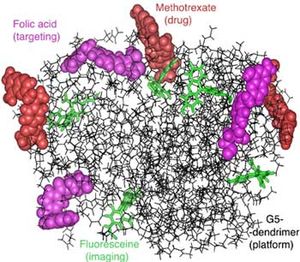Dendrimers
Dendrimers are complicated molecules with tree-like branches or arms. They were first created in the laboratory in 1979 by Donald Tomalia, a chemist working for the Dow Chemical Corporation. Both the shape and chemical composition of dendrimers can be readily engineered, making them useful in medicine. Researchers can design dendrimers so that they can be injected into the body and attach themselves to particular kinds of cells.
All sorts of materials, from metals and drugs to genetic materials, can nestle in the branches of the dendrimers. And their small size means they tend to pass through the walls of the cells to which they attach. Once inside the cell, chemical reactions cause the dendrimers to release the materials they carry. For example, researchers at the University of Michigan have successfully demonstrated dendrimers that can locate and attach to human cancer cells that have been implanted in mice. They hope this dendrimers will lead to an effective drug treatment that would reduced the amount of drugs (as well as the harmful and unpleasant side effects) needed to treat the disease. They can even attach other molecules to the dendrimers to allow them to visually track the progress of the drug through the body with special imaging equipment.
Dendrimers also link nanotechnology to another growing field: genetics. By embedding genetic material into the dendrimer’s branches, researchers hope to accomplish “gene therapy,” where defective or deficient genes are selectively replaced inside cells. This kind of therapy was previously attempted using a genetically modified virus, which also attaches to cells and injects its DNA, but the body would recognize these “friendly” viruses as a disease and would attack them. With dendrimers, however, there is no such immune-system reaction. However, there are still concerns with dendrimers being toxic in living animals, so engineers are still working to convince doctors that they are safe enough to use on humans.
